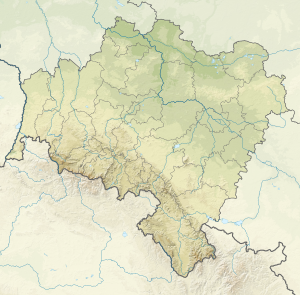Świecie Castle
| Świecie Castle | ||
|---|---|---|
|
Świecie Castle ruins |
||
| Alternative name (s): | Schwerta Castle; 1937–1945: Schwertburg (German) | |
| Creation time : | First mentioned in 1329 | |
| Castle type : | Hilltop castle | |
| Conservation status: | ruin | |
| Standing position : | ducal residence | |
| Place: | Zamek w Świeciu | |
| Geographical location | 50 ° 58 '52 " N , 15 ° 17' 19.2" E | |
|
|
||
The ruins of the castle Świecie (German castle Schwerta , 1937-1945: Schwertburg ) is located in the village of Świecie ( Schwerta ), which has belonged to the rural community Leśna ( Marklissa ) in the Lubański powiat in Poland , about five kilometers south of Leśna on a gneiss rock since 1945 .
history
The castle "Sweta", which belonged to the Queiskreis in Upper Lusatia , was first mentioned in the contract of May 3, 1329, in which Duke Heinrich I of Schweidnitz and Jauer confirmed the return of the country of Görlitz to the Bohemian King John of Luxembourg . The Queiskreis, which consisted of the districts of the castles "Sweta", "Caychaw" and "Lesna" , was to remain in the possession of Henry I. It is not known who built the Schwerta Castle. It is possible that it was created before the Queis border was established before 1241 and goes back to a system of the Piastic Dukes of Silesia , who wanted to influence the demarcation along the Queis .
The castle district of Schwerta, which consisted of about two-fifths of the Queiskreis, initially included the villages and knight seats of Schwerta, Gebhardsdorf and Meffersdorf . After the death of Duke Heinrich I in 1346, the Queiskreis fell to the Crown of Bohemia as a settled fief . In 1385 at the latest, the castle and lordship of Schwerta passed to the Uechtritz family . In 1550 they created the village (Alt) Scheibe, which also belonged to the Schwerta castle district. After a fire in 1527 the castle was restored and enlarged by them.
After the extinction of the Schwerta branch of the Uechtritz, the Schwerta rule was divided into three parts in 1592, which remained in the hands of another branch of the Uechtritz family until 1638:
- Schwerta, with about 13 km²
- Gebhardsdorf with about 15 km² with the refugee settlement Estherwalde
- Meffersdorf with about 12 km². In 1667, the Wigandsthal refugee settlement was built on Meffersdorfer Grund .
In 1635, the castle and rule of Schwerta, together with the Queiskkreis, fell to the Protestant Electorate of Saxony . In 1665, Schwerta was acquired by Daniel von Loeben , who was followed in 1719 by the Saxon field marshal Jakob Heinrich von Flemming , who after six years sold it to the Polish-Saxon minister Jan Kazimierz Rayski. In 1729 August the Strong took over the castle and rule of Schwerta and sold them to Colonel Wolf Adolf von Gersdorff .
After the Congress of Vienna in 1815, Schwerta fell to Prussia, along with Ostoberlausitz including Lauban and the Queiskreis . The area was incorporated into the province of Silesia , with which it shared its further history. The castle Schwerta, uninhabited since 1760, burned down in 1820. The ruin was not rebuilt. Ernst von Gütschow, the owner of Tzschocha Castle , intended to rebuild the castle, but this did not materialize because of the First World War. As a result of the Second World War, the area was ceded to Poland in 1945 and the urban German population was forcibly resettled.
literature
- Hugo Weczerka (Hrsg.): Handbook of the historical places . Volume: Silesia (= Kröner's pocket edition . Volume 316). Kröner, Stuttgart 1977, ISBN 3-520-31601-3 , pp. XVII, 114, 424 and 498.

